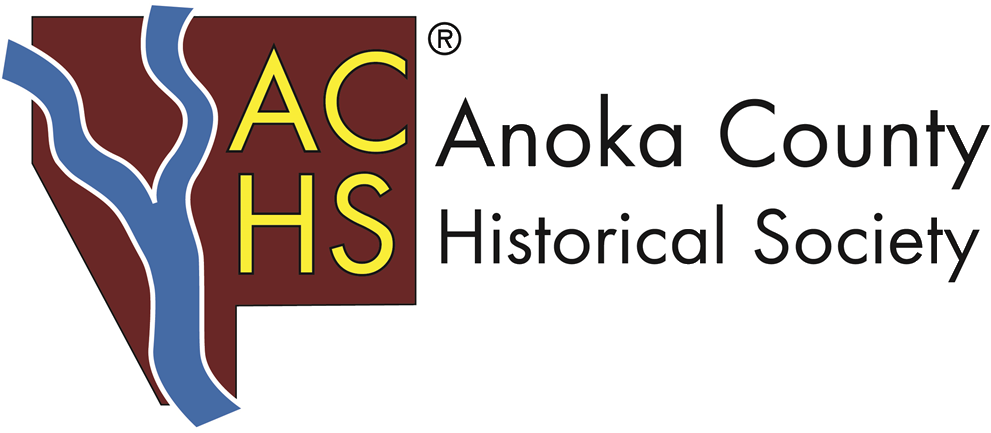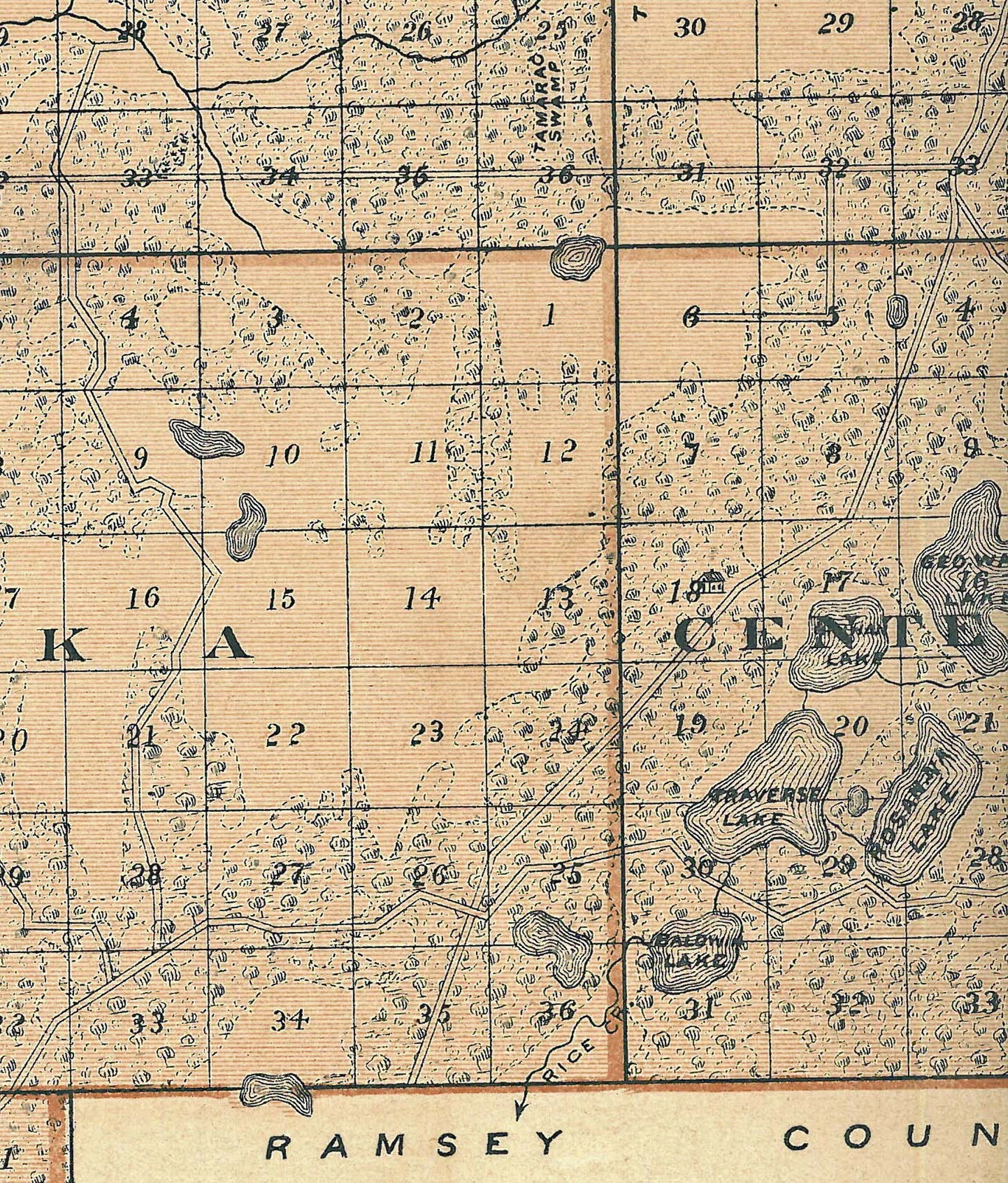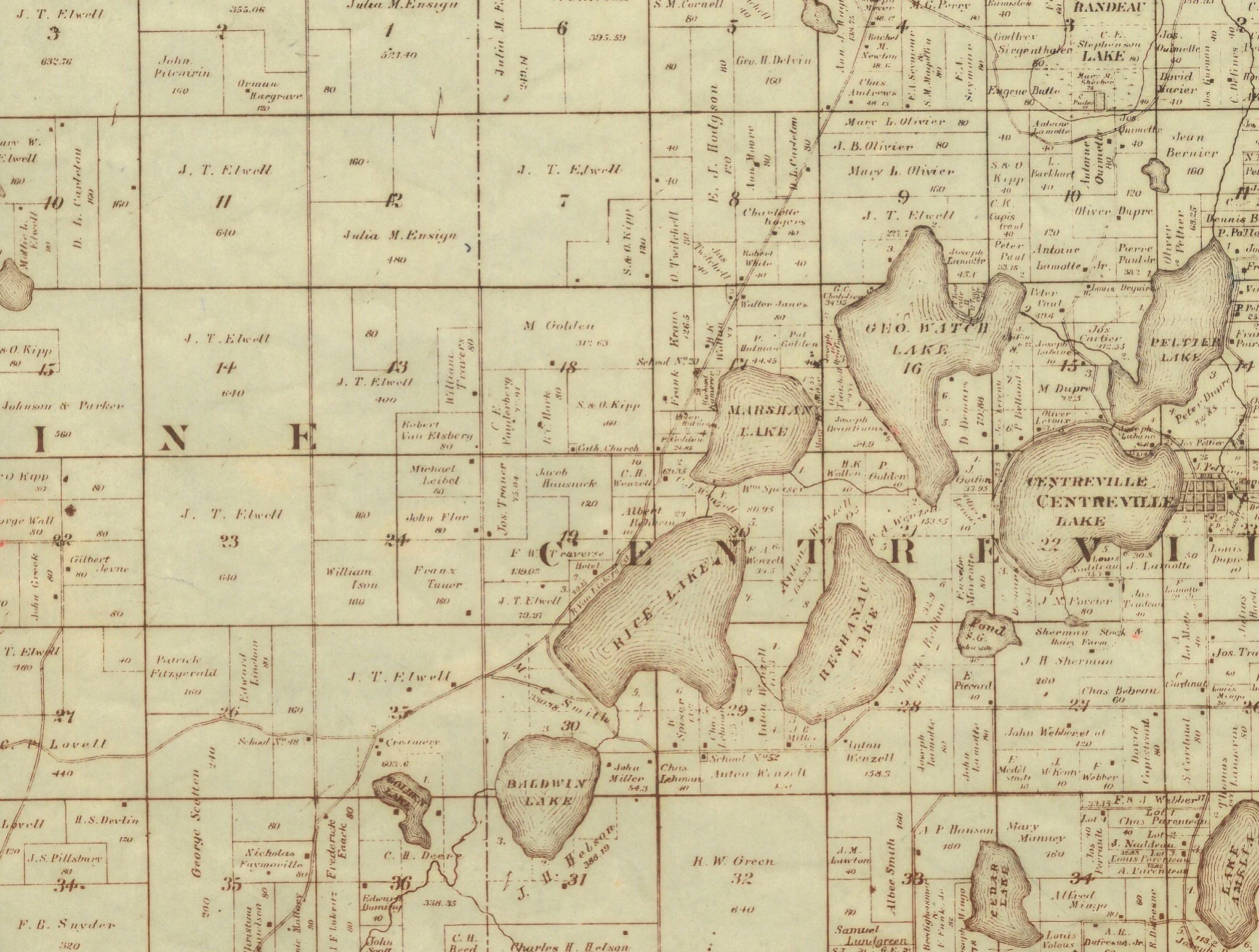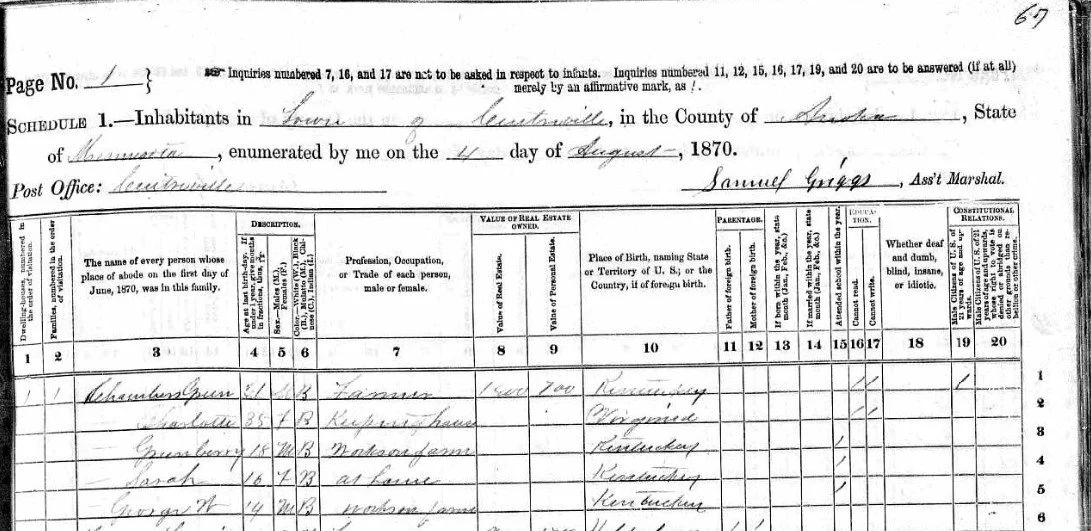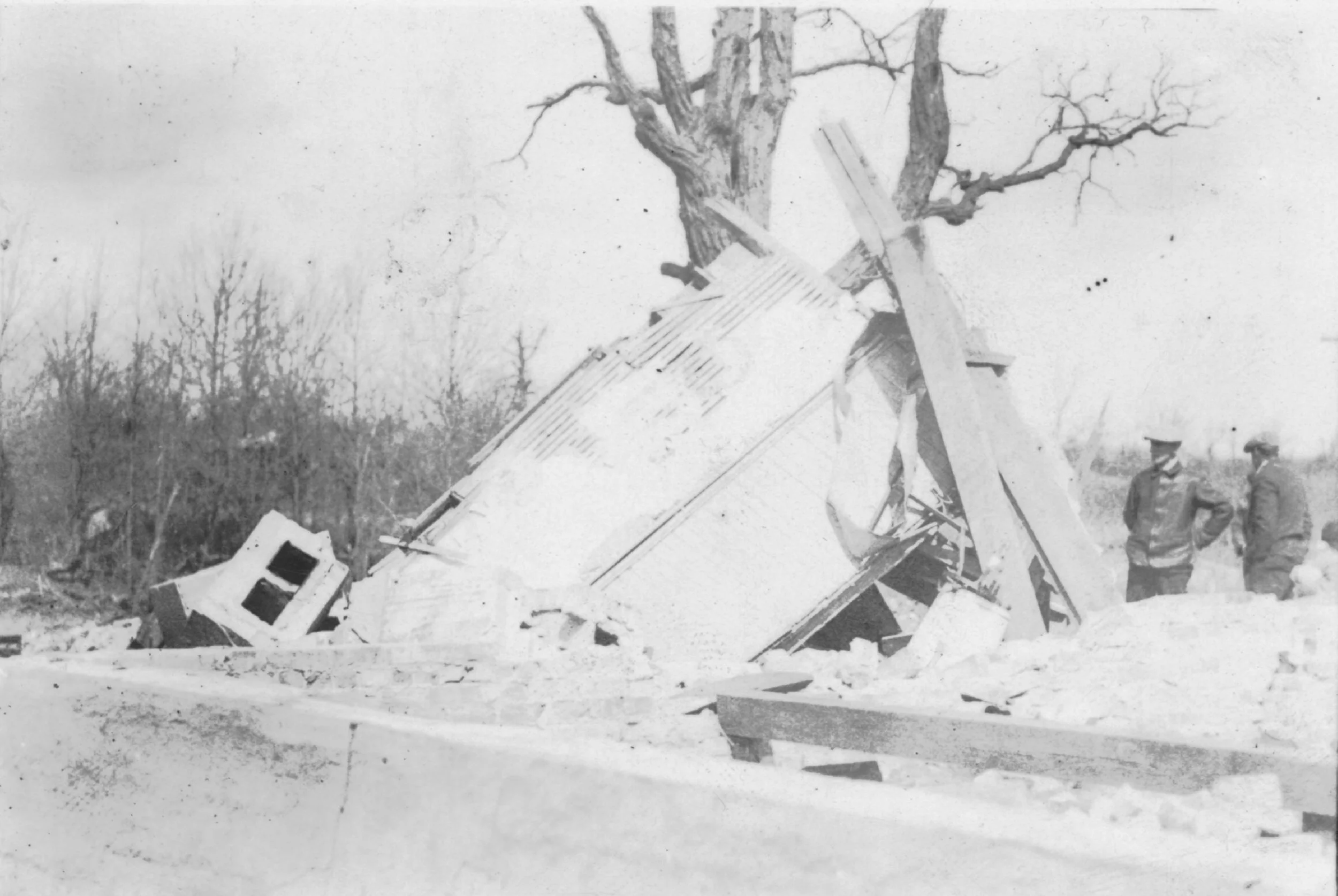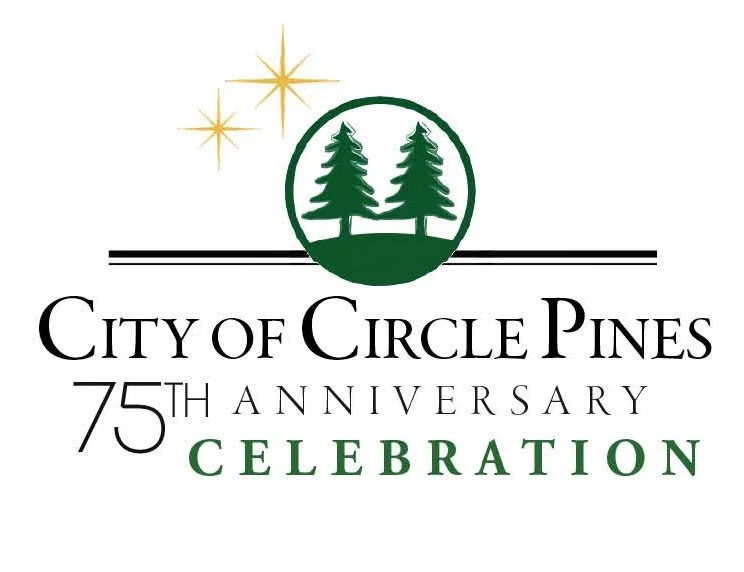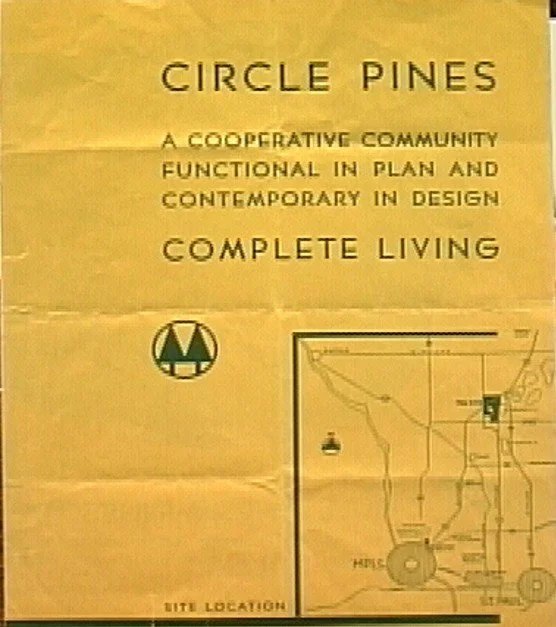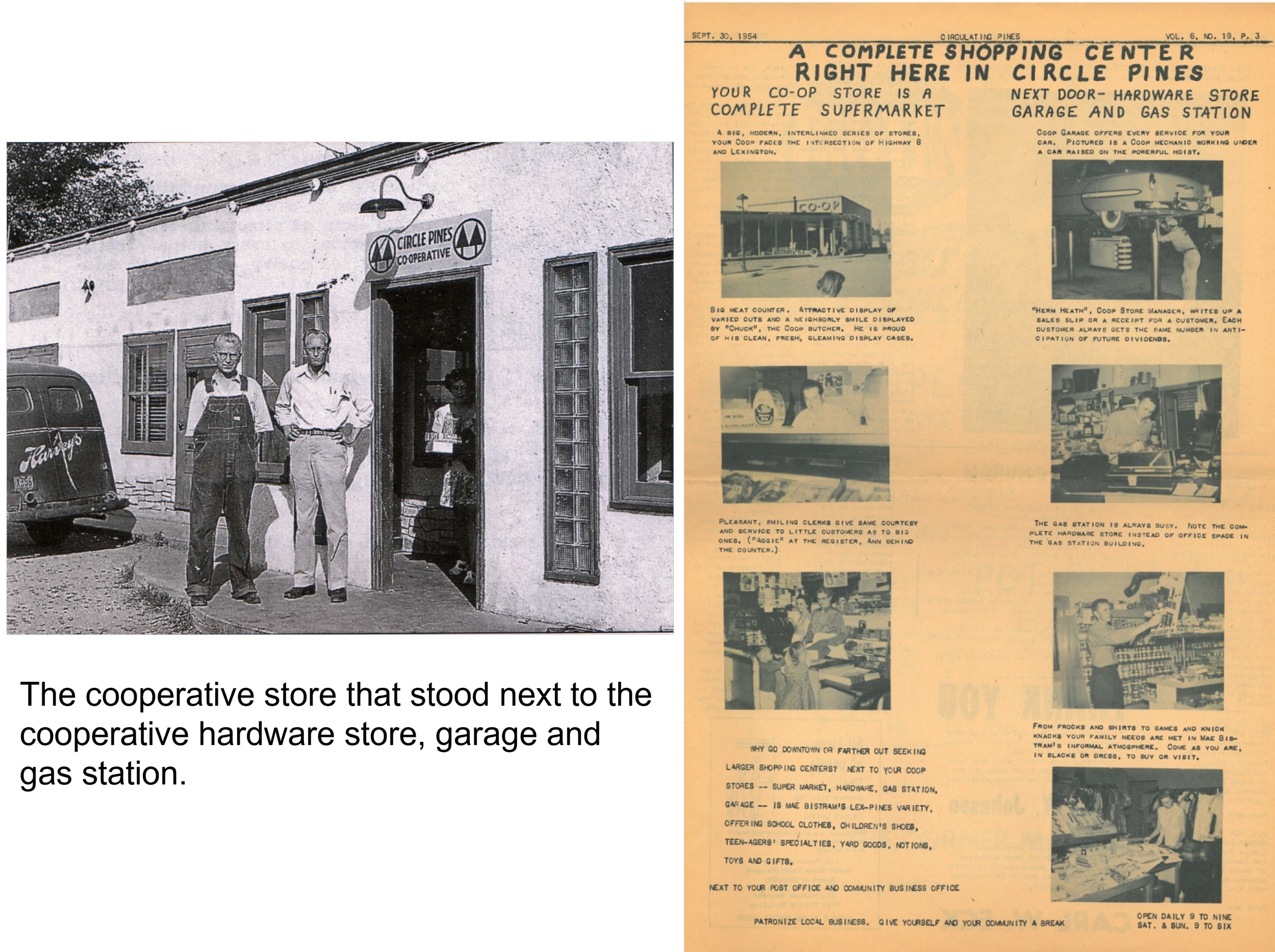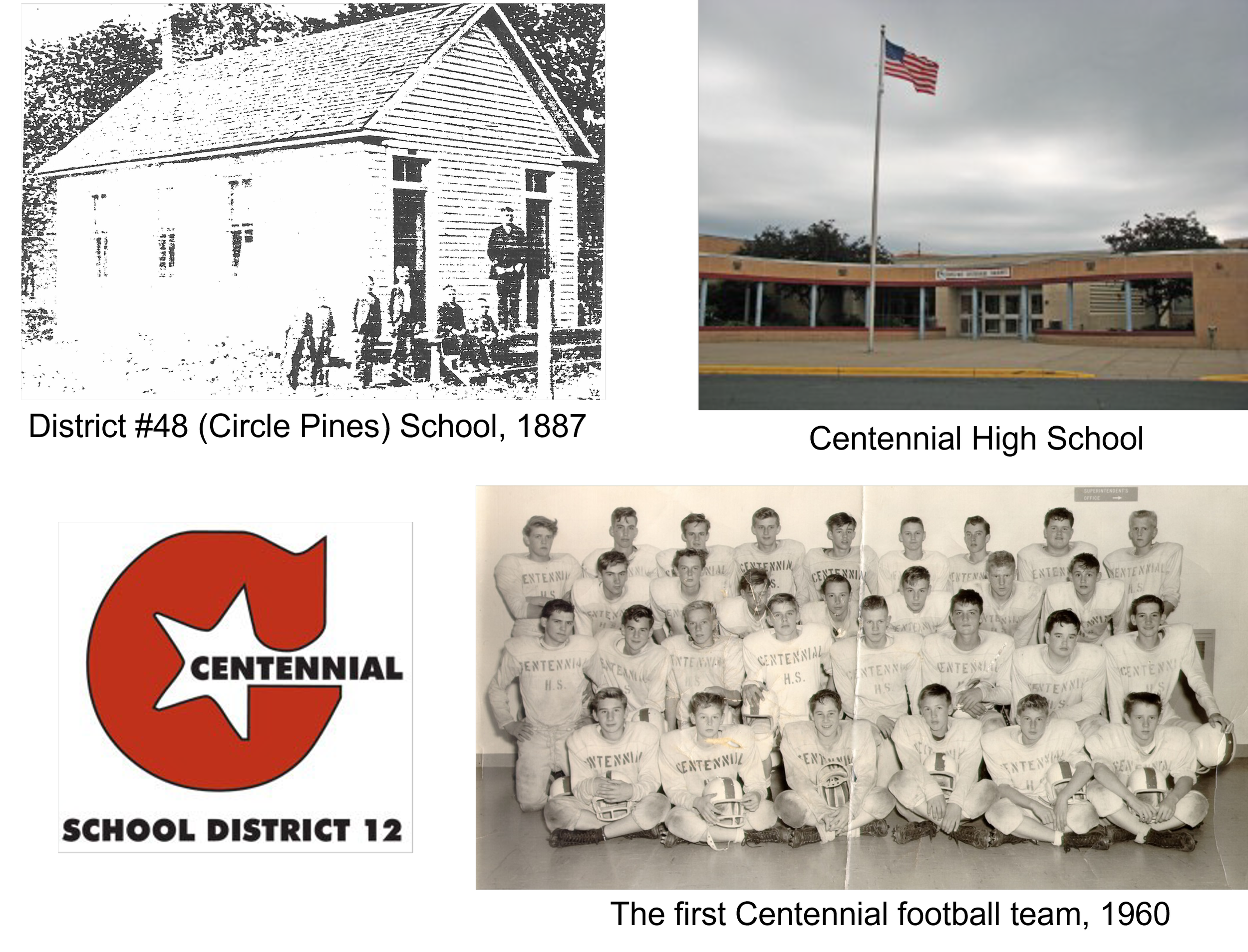Circle Pines
This is a color photo of one of the Circle Pines Police officers in a police car. The car is in one of the school parking lots, possibly ready for a parade—photo from the Rienald Schootens collection, object ID 2016.1716.005.
At a glance
Circle Pines began as a Cooperative Community, inspired by Valdemar S. Peterson. The community members owned and ran businesses and city services collectively.
• The first 10 homes built by the Association were “Cemesto” homes, prefabricated houses built in Texas. They had slab foundations with grooves around the perimeter, where a cement sheet was set to form the walls. The houses stood on either side of West Road, starting with #5.
• Minnesota’s first female Supreme Court justice, Rosalie Wahl, was an early resident of the cooperative community. She briefly served as editor to the local newspaper, Circulating Pines.
Did you know?
Before incorporation, the land was part of both Blaine and Centerville townships
1946: Plans to build a cooperative community were announced by the Golden Lake Development Association
1950: Incorporated as a village 1974: Received city status
A conversation with Mayor Dave
Born: David Lee Bartholomay on February 24th, 1955. Changed it to Thompson when I got married. Thompson is my mother's maiden name.
Parents: Gale and Selma Bartholomay from Fargo, North Dakota.
Residence: Circle Pines since 1997
Education: Bachelor's degree and a Master's degree in political science via North Dakota State University and Arizona State University, with plans to become a City Manager.
On May 27, ACHS sat down with Dave Bartholomay to recount his time in service as Mayor of Circle Pines. This is a portion of the recorded interview.
...However, I took a course called negotiating with police and firefighters. It started to wake me up to how some of the challenges of being a city manager, city administrator is a tough job, and also the challenges of working with elected officials. And I found myself really too political to be a city administrator. You just have to have no opinion on a lot of things and I happen to have a few opinions on some things so I decided it really wasn't the field for me.
Well, it's one of the things that drew me to local government. I have been asked multiple times to run for the state legislature. Some people have suggested I should go for other offices higher up, and I always smile because this higher up is an interesting term to use. A lot of people do use a elected position as a stepping stone for something down the road. I'm always flattered that people think I could do a good job in other positions, however, I think the most important thing is local government, I happen to think that I can make a difference here.
I'll tell you a short story that explains it all. My wife Janice and I are both master gardeners, we live on West Golden Lake Road. We have beautiful flowers and plants in the front, and people are often stopping by and looking at them and talking to us. And Janice and I were up there a few years ago, there was an opening on the county board for our area, our county commissioner was becoming the county administrator. And so this position was open, people were suggesting that I should run for it. The mayor of a neighboring town was going to run for it, he and I have often bumped heads over the course of years.
So Janice and I always have this discussion, what's the pros and cons? Should I do this or not? So we were looking at it and it was a little difficult because I had a full-time job and this thing would connect with that a little bit and stuff, so that was unfortunate. But we were chatting back and forth, it's hard to tell should you do it or not. And two kids rode by, and they were probably 10, 12 years old on their bikes, it's a summer afternoon, and they're riding by. And as they ride by, I'll never forget, I don't know who these kids were, just neighborhood kids, and they rode by and they waved their hands and they said, “hey, Mayor Dave, how are you doing?”
And I looked at those kids and I thought to myself, if they know who their mayor is, that's pretty cool. And I can make a difference for those kids, and I have been trying to do that at Golden Lake Elementary and work with the school board and the schools. I'm in the Hall of Fame for the Centennial School District even though I've never attended school here, but just for my continued support.
So Janice and I talked and we decided, if you're having the impact where kids know your names and they like you and you're doing good work for them, then that's enough. And so we decided we're not running for anything else, we're staying right where we are, we're having an impact, we're making a difference, that's the whole point is servant leadership, trying to serve others. And I know people get—there's egos involved, I have one, everybody's got one, but being able to actually make a difference for kids like that, that just means the world to me.
So being local is exactly a major difference. Remember, I've worked for two congressmen and a couple governors, so I've been there when the crowds come and everybody thinks you're great and says nice things about you and pumps you up, I've seen all that, and that's a neat kind of feeling. However, this is a situation where I go to the grocery store, I go to the bar to have a beer, I go to a high school basketball or hockey game, people come up to me, they know me, they talk about the issues, they ask, “what about this?”
It can be something so simple as, “my street lights out,” or it can be, “I've got some concerns about a house down the street,” and they're just there and you're able to help them and deal with it and build a better community. And for me, that's just been plenty, I've loved it. Sometimes I do wish I had ran for the county board, but I'm happy where I'm at.
Read the whole transcript at ACHS!
1874 map of the area showing Traverse Lake, Baldwin Lake, and Rosanna Lake.
In the Beginning
Since the communities of Circle Pines and Lexington were carved out of what had been Blaine and Centerville, their early history is interwoven.
The first people to live here were, of course, Native Americans, though this was not a permanent home for them. The Native Americans gathered wild rice, cranberries, and other seasonal harvests from camps that were along the Rice Creek Chain of Lakes, but this area was not their permanent home. There is evidence of human habitation dating back as far as 6,000 years ago, but more recent evidence suggests that the Ojibwa camped here during their harvest times. Other evidence suggests the Dakota also came here to harvest rice, but these were only temporary camps.
The area was open to legal European settlement by 1851, and evidence in land records indicates that many of the first settlers in the Blaine area, especially those in the vicinity, were speculators. They grabbed up as much land as they could, often by hiring squatters to settle on the land with the understanding that when the clear title came through, it belonged to the spectators. These individuals were purchasing government land at the lowest possible price, hoping that its value would increase and they could sell it at a substantial profit.
The reality was that this area was covered by extensive bogland, which could not be farmed in those earliest years. Still, people came here for a new start.
Some of the earliest settlers came to the northern shore of Rice Lake. Fredrick Travers built his house there in 1850. He was born in Germany, came to America in 1841, and enlisted in the U.S. Army. He was serving at Fort Snelling here in Minnesota when he was discharged. Fred stayed in Minnesota, and after several moves around the area, he built a house on the shores of Rice Lake, where he hunted, fished, and farmed to make his living. His wife was Jennie, a French Canadian, and they had three children.
Life would not have been easy here in the 1850s, so Fred’s trapping, hunting, and fishing probably provided the majority of their meals. Even his death notice in the newspaper in 1900 noted Fred’s “considerable fame” as a trapper. He was also noted as the first white man to build a house in what would become Centerville Township.
George Townsend and Friends
George Townsend claimed land around where Centennial High School stands today, but he didn’t stay long and left very little information about himself for us to find.
Another early settler who did stay was Michael Golden. He brought his family to America to escape the Irish potato famine. He claimed 160 acres in the area where the Centennial Middle School was built in 1997. Golden Lake is named for this family.
Some records indicate that a road was built through this area as early as 1847, running along what is now known as Hodgson Road. It originated from St. Paul, traversed the area between Baldwin and Rice Lake, and then turned north. Roughly that same route was laid out as the Kettle River Road in the last half of the 1850s. This road was the stage road during those early years.
When another road was built through here, coming from St. Anthony, close to the same route as Lake Drive today, the two intersected near what is Lake Drive and Main Street. There was a stage depot there as they often needed to change horses on the eastbound stage at this point. The soft sand of the Anoka County sand plain to the west made pulling the stage a lot harder, and tired the horses out so much that they needed to be changed out after getting through all those sandy roads.
Just a fun fact—Radisson Road got its name because it was the road used to deliver farm produce and cattle to the Radisson Hotel in Minneapolis from a large farming operation in Blaine in the 1880s.
Anoka County was organized in 1857, and at that time, there were only eight townships and no villages or cities within the county, so this area was known as Anoka Township. It was not until 1877 that Blaine was organized, and it included all of what today is Lexington and most of Circle Pines.
The name Blaine originated from the area's strong Republican leanings and the local town board chair, who was from Maine. They chose to name their community after James G. Blaine, a three-time unsuccessful presidential candidate from Maine.
Three years later, the 1880 census recorded a population of 128 people living in Blaine.
1888 map showing the changing development of the area.
1870 census record
Green Chambers, Civil War Pension Index, 1882
Green and Greenberry Chambers
Green Chambers was born a slave, but he died a free man after farming for many years in Anoka County. His birthplace was Barron County, Kentucky, between 1810 and 1825, depending on which record is used. It is possible Green himself did not know what year he was born. He was owned by James M. Gillock and was inherited by Gillock’s sons when James died. Green was sold and was owned by Francis Chambers when the 1860 Slave Schedules were recorded. It was from this master that Green took his surname, Chambers. Green and his wife, Charlotte, were married in 1851 and, over the next years, had five children. At some point, Green was separated from his family.
It is unclear whether Green was freed or escaped, but he enlisted in the Union Army on September 20, 1864, joining Company H of the 115th US Colored Regiment. This regiment participated in the siege of Petersburg and occupied Richmond before sailing for Texas, where they served in the Rio Grande District. Green served as a private. At one point, Green was helping to erect a stockade when a log slipped and he was injured. He spent some weeks in the hospital and was honorably discharged.
One story about Green says he went in search of his children, whom he found, though it was with some difficulty since they had been released from their master. Once his family was reunited, Green moved north, coming to Anoka County in 1865. Records are incomplete, but it is believed that Green took up farming on the abandoned homestead of George Townsend, which is thought to be located near the Centennial School Campus in 2013.
This is where the 1870 census recorded Green and his family. The census indicated that Green owned the farm, and it had a taxable valuation of $1,000. There were 30 improved acres, meaning they were under cultivation, and another 130 that were not improved. The family had two horses, seven head of cattle, and 12 pigs. They raised spring wheat, Indian corn, and oats, making it one of the top-producing farms in the area in 1870.
Green’s 18-year-old son, George, died in 1874. Then, in 1875, the sheriff foreclosed on the farm because they owed $677.70 on it and were unable to pay.
Where the family lived next is not known, but the 1880 census puts the family on a piece of land in Blaine. They had horses, milk cows, pigs, poultry, and one sheep, and were raising oats, wheat, and potatoes, as well as selling firewood.
Green and his son, Green Jr., sometimes called Greenberry, were the first people to vote in the Blaine Township elections in 1881.
In the next couple of years, Green and Lottie moved to St. Paul, where Lottie helped support the family by taking in laundry and ironing. Green worked as a porter on the railroad.
Lottie died in 1884 and was buried in Oakland Cemetery in St. Paul.
Green was still working for the railroad when he died of “old age” in 1898. He was buried beside Lottie and rests with a military marker recognizing his service to the US Army.
James Elwell and the Springs
James Elwell grew up in Minnesota, attended Carleton College, and by the age of 17, had patented a new kind of bedspring. The company that began making bedsprings evolved into the Minneapolis Furniture Company and the Minneapolis Bedding Company, both of which were highly successful before he sold them to his brother.
James then bought land in what would become southeast Minneapolis. He got it cheap because it was considered wasteland—full of bogs and wetlands. James put in miles of box drains and drain tiling, and soon had 55 homes built and sold on the now stable land.
James first considered investing his profits in Red River Valley land, but instead decided to start buying land much closer to home, in Anoka County. It was in 1886 that he first acquired some of the wetlands and bogs on the east side of the county. His first stock farm (beef and milk cattle) was the Oak Leaf Farm in Ham Lake, followed by the Golden Lake Farm, which had its offices located near where the Circle Pines City Hall and Centennial Library are situated today. He planned to buy what was considered worthless land at a cheap price, drain it, and resell it at a profit. At one point, James Elwell owned 52,700 acres within Anoka County. He dug some 200 miles of ditches to drain that land and make it farmable.
Not only did these ditches drain the land, but by digging a ditch on each side and piling what was dug out in the middle, he built a fine road between his stock farms. It was called the Elwell Grade. Today, it is part of Lexington Avenue that runs between Lake Drive and the city of Ham Lake.
J.T. Elwell farm on golden lake in 1892 (Object ID CP13)
February 10, 1915 edition of the Anoka Union.
Prohibition: A Storied Era
Anoka County went dry in 1916, four years before the national prohibition, so stills were illegal here—but certainly not uncommon! One raid in 1926 was on the north shore of Golden Lake. Anoka County Sheriff Pratt and his deputies found three stills there, and they arrested two men, but the man who had rented the land escaped and was never seen here again.
The stories were that one of those three stills raided belonged to a gang from St. Paul known as the Messina Gang. The Messina gang was part of the mafia branch that police believed controlled the liquor trade in St. Paul. They were none too happy about losing their still and the arrest of Willis Goff, one of their members. They bailed him out of jail and expected him to keep the vow of silence that all their members were sworn to.
Goff expected the gang to pay $25 a week to take care of his family in exchange for that silence, but when the payments lagged and suddenly there were four more raids on Messina Gang liquor operations, the gang believed that Goff had talked.
Goff was last seen near a store run by the Messina Gang, where he was given $5 by a man the police believed was a gunman from Chicago.
About two weeks later, a man out looking for mushrooms near Golden Lake stumbled upon a decomposing body. When the Sheriff and the coroner came, they found two bullet holes in the skull and no identification on the body, only 78¢ and a bus transfer. The bus transfer did eventually lead to someone who could identify the body as that of Willis Goff.
One member of the Messina family and the suspected Chicago gunman were arrested. Still, people soon appeared, swearing the two men were in Wausau, Wisconsin, at the time of the murder. The Chicago gunman was released, but the Messina family member was held on charges stemming from the moonshine operations that had been raided.
No one was ever convicted of the murder of Willis Goff, but stories about the man continued for years, and many people remembered when they were children that they would run past the site where the body was found for fear of Willie’s ghost. Another story that continued for years was if a child was seen putting a coin into their mouth—like children often do—their parents would say, “That coin might have been in Willie Goff’s pocket!” Willie Goff was the “boogie man” of Circle Pines!
To OZ We Go
1929 might be remembered in national history as the year of the stock market crash and the start of the Great Depression, but in this area, it was also remembered as the year of the twin tornadoes. It was April 5, 1929, and the pair of tornados came from the north edge of Minneapolis up through the Rice Lake area and on north into Forest Lake. There were 17 people killed by the storm, 160 more injured, and some 200 farms destroyed along the storm path that covered 21 cities and townships.
Newspaper accounts tell of a mother and child who were blown from their house into Rice Lake. Both survived and were—miraculously — unhurt. Another witness, Katie Frischmon, was near the corner of what today is Lovell Road and Lexington Avenue. She told the newspaper what she saw as the storm came: “It seemed the whole southwest end of Minnesota was about to be piled right on top of us. It made a hissing sound which grew louder and louder as it drew near. Then it took on all the beautiful colors of the rainbow, bright red, white, grey, and then they all blended into a black, hissing monster ready to wipe us off the face of the earth.”
The photo shows the destruction of District #48 School following the tornado. It stood where the Lovell School was later built. There were pieces of school desks found in the fields around the area for more than ten years after the tornado and a piece with a student’s name carved into it was even found in a swamp near Forest Lake.
Batter, Up!
This girls’ baseball team from Rice Lake played in the 1920s. It was a favorite pastime for people of the area—either playing or watching their local teams. This continued into the 1930s and the depression, but the hard times did take a toll on the baseball teams. No equipment and no money did not stop the games; teams just made do with a ball made from a string and rubber strips cut from an old inner tube. Bats were easily made with an adequately sized straight branch from a tree, the bark peeled off, and whittled smooth.
Note, however, that although women gained the right to vote in 1920, many doors remained closed to them. They could have a ball team, like the one in the Rice Lake area did, but the team's manager was a man. He is in the center of the back row.
Gordon’s Corner
In about 1941-42, Gordon Huse and his wife, Mildred, moved to the area as Gordon was convinced this neighborhood was going to grow rapidly and become the “next Edina.” Mildred wasn’t so sure, but she moved here with her husband.
They built this service station on the northwest corner of Lexington Avenue and Highway 8, and it soon became known as Gordon’s Corner. Gordon persuaded Mildred to sell food to travelers when they stopped, so he built a small stand with two pop coolers in front of the station. When that was successful, they added ice cream and hot dogs to the menu.
Eventually, the corner grew to include a garage, a gas station, a TV repair shop, a small grocery store, a café, and a hardware store.
It was even the “movie theatre” for a time in the summers of the 1950s when a man came out and set up a projector in his van to show movies on the back wall of the building.
A fire in 1970 destroyed the entire complex.
Gordon’s Corner, ca 1940s
Wait, it’s here!
The beginning of Circle Pines!
Whew…it takes a lot of history to get to the present — or at least to 75 years ago
The idea for a cooperative community originated from Valdemar S. Peterson, but most people knew him by his nickname, Pete.
Pete had been a banker, but when the stock market crashed in 1929 and the great depression came, he lost his bank. He worked hard to pay back his debts, but he was almost obsessed with the idea that something was wrong with a system where people had so little power over their economic fate. He had done nothing wrong, but there was nothing he could do to prevent his bank from failing. He believed money should be a tool to use, not as he put it, “letting the tail wag the dog.” He became very interested in cooperative ventures and credit unions where people shared in both the profits and the risks. Those who supported these cooperative ventures held many picnics where speakers gave talks on the benefits of people working together. Pete and his wife helped arrange a camp for having these kinds of discussions on the old Golden Lake stock farm, and it was while at that camp one day in 1945 that Pete suddenly sat up and announced, “I have an idea.”
Peterson wanted to build a cooperative community. He thought that people could save money through a collaborative venture to mass-produce houses and create a sustainable cooperative community. Profits would be distributed to the cooperative's members. He found two men who shared his views, Thomas Ellerby and Paul Steenberg. Both had suffered losses in the depression, and both believed a cooperative community was a better alternative.
In May of 1946, the men formed the Golden Lake Development Association. They announced plans to build a cooperative village of 1,203 acres “to unite the habitation benefits of a functional and contemporary community with the economic advantages of a consumer's cooperative.”
They had grand plans. Each house would front a park or a walkway. There would be adult education, nurseries, educational and recreational activities for all ages. The commercial facilities needed to support a community would all be owned cooperatively, as would the municipal utilities. Any profits generated by these entities would be reinvested in the community.
The kind of homes to be built was controlled—depending on the area, a house could not cost less than $4,000, $6,000, or $8,000, but no house could exceed $20,000 in building costs.
Each member of the community was required to purchase at least one share in the cooperative at $100 per share. The Golden Lake Development Association anticipated building 500 homes in the first year.
It was later in 1946 that they changed their name to the Circle Pines Development Association in honor of the national cooperative emblem that showed two pine trees within a circle. The trees symbolized life and endurance, their roots growing outward to form a circle that symbolized the world.
This symbol is still the logo used by the City of Circle Pines, though the pine trees have been updated.
Since this was to be a cooperative community, community members were expected to do all the jobs that needed doing, such as the postmaster. This Postal Department registration book lists V.S. Peterson as the first postmaster when the post office was established in Circle Pines. The subsequent postmasters were mistresses, with Mrs. Peterson taking over from her husband.
To keep members informed about what was happening in their cooperative, advertise the cooperative store's products, and disseminate news, a two-page newsletter was sent to residents starting in 1947. The title was “Circle Pines—the Cooperative Way.” V.S. Peterson was the driving force behind it, and after he died in 1950, there was no community news sheet.
What took the place of the news sheet was a postcard sent out by the Circle Pines village clerk, Andrew Gibas. He sent out the meeting agendas and other news to all residents. When the news became more extensive than he could fit on a postcard, a group of citizens decided to create a newspaper to serve the community of Circle Pines.
The first editor of the paper was Rosalie Wahl. If her name sounds familiar, she went on to become the first woman to serve on the Minnesota Supreme Court. She had some journalism experience—and another benefit was that her husband, Ross, had a mimeograph machine.
The postmistress, Fylla Peterson, volunteered to pay the postage costs for mailing the newspaper to residents. Each paper cost one cent to mail. Fylla was Valdemar’s wife.
In January of 1951, they produced 100 copies of a four-page news sheet for the residents of Circle Pines. By March, they were organized enough to ask their readers to vote on a name for the paper.
The choices were the Circle Pines Community, The Circulating Pines, The Murmuring Pines, The Pines Times, and Circle Pines New Sheet.
The editor, Mrs. Wahl, was a bit miffed when they received no votes for any of the names.
That was when Grace Gibas, the wife of the first village clerk who mailed out those postcards, voted for the name she had jokingly suggested, and the Circulating Pines was named.
In 1953, the business office for the paper was located in an apartment, with Andy Gibas and Sarah Cunningham serving as co-editors. Another resident volunteered to print the paper at his printing business in Minneapolis. The following year, the paper was incorporated as a nonprofit organization, with any income from the sale of advertisements or newspapers to be donated to charity or used for a public purpose.
What to do with profits was never a problem, as it was not long before the newspaper became known as a subsidy newspaper, meaning that it never made a profit and sometimes only managed to stay afloat because the editors paid the bills with their own money.
The editors who provided the most monetary support for the paper were Andrew and Grace Gibas. They became co-editors in 1960 and continued in this role until the paper closed in 1994.
Under the leadership of Andrew and Grace, the paper became a “legal” paper, meaning it could print legal notices, such as minutes for local cities and school districts. Those helped pay the bills, but advertising never really took off, in part because of the newspaper’s size and also due to the paper’s roots.
Grace and Andrew were staunch supporters of the cooperative community, and they aggressively reported on civil activities and local politics, stands which sometimes alienated advertisers and even readers.
The paper gained national attention in 1962 when it began running stories about AT&T and how it believed that the mega-company was overcharging its long-distance customers by a billion dollars. Even though the article was read in a session before the US Senate, it did not win everyone over as friends of the Circulating Pines.
Throughout its existence, the Circulating Pines and its staff won numerous journalism awards, including a first-place award from the Minnesota Newspaper Association in 1969.
Notorious Folks
Sara Rosalie Wahl came to Minnesota in 1949. She said they came to Circle Pines because it was a hopeful place and they wanted to build a new life. She described their arrival as being in a 1934 Chevy with all of their possessions, including Tarzan, their old cocker spaniel, and a fourteenth-month-old baby.
Being a cooperative community, people expected them to participate, and Rosalie—she didn’t go by Sara—did. She was one of those who had the idea to start a community newspaper, and she was named the first editor. Their plan when they moved to Circle Pines was to build houses and start some economic venture. Their first house in Circle Pines was only a basement, and it was shared with another family.
Two more children were born while she lived in Circle Pines, but after 10 years of trying to make their cooperative community dream a reality, it just didn’t happen. Rosalie said she didn’t consider the cooperative community idea a failure—it lasted ten years and everyone learned a great deal from the venture.
It was after leaving Circle Pines that she returned to school to earn her law degree and eventually became the first woman appointed to serve on the Minnesota Supreme Court in 1977. She was known for her efforts to address racial and gender bias in the state’s justice system. She wrote more than 500 legal opinions during her 17 years of service on Minnesota’s highest court.
She passed away in 2013.
EVENT: Women in Politics – Tuesday, November 18, 6 p.m.- 8 p.m.
Pick up a copy of Until There is Justice or Her Honor: Rosalie Wahl and the Minnesota Women’s Movement and learn more about the essence of systemic change. How have women impacted our government? What challenges lie ahead?
Another notable person from Circle Pine is Dave Dahl, the chief meteorologist at KSTP Television. He is from one of the founding families in the cooperative venture. His father was the building inspector for the new town.
It was while growing up in a house in Circle Pines that Dave found his interest in weather. Dave was 12 years old when the 1965 tornadoes hit. He traces his own 30-year career back to that single night, saying “The May 6th, 1965 tornado outbreak was the start of my interest in weather. A twin tornado tracked through Circle Pines that night, which is where I lived, causing considerable damage to part of the city. My sisters and brothers and I all huddled in the hallway of our home because we didn't have a basement. It was a scary night!”
Dahl attended the University of Minnesota and earned his degree in meteorology from Florida State University before becoming a part of the 5 Eyewitness News team in 1977. He has also produced a documentary on tornado-chasing for The Weather Channel and a special report on The Discovery Channel for his tornado chasing in April 1996. He says he continues to work to “teach our viewers how to deal with weather of all types, and in particular, guide them safely through severe weather.”
The Post Office
Sorting Circle Pines Christmas mail, 1950. Before 1949, mail for people living in this area was sent to New Brighton, but Circle Pines established its own post office that year. Cooperatively, the mail was brought into the café (which was also the post office) and left on a table. Residents stopped by the café to pick up their mail. V. S. Peterson was the first postmaster, and Ellen Madsen Larson helped him out during the Christmas mailing season.
This was the first post office for Circle Pines. V.S. Peterson is in the center with two postal officials on either side of him.
The Centennial Branch Library
The first library in Circle Pines originated when Elsa Carlson volunteered a spare bedroom in her house for use as a community library. She quickly had donations of more than 200 books, primarily novels. When she ran out of space, the books were moved to a corner of the cooperative store. Later, the Lovell School library was opened for public use.
The Anoka County Library system now serves the area. This photo shows the opening of the first county library in Circle Pines, now known as the Centennial Branch, taken in the late 1960s.
On the original, you’ll notice the “crop marks” on the photo (small black angles), which are because it came to ACHS from the Circulating Pines and was probably one they used in the newspaper at some point. The original photo was marked with the printer’s proofing marks, indicating how the picture should be cropped for the newspaper.
Check out more information on the Anoka City Library and the Anoka County Library System in the ACHS database.
In partnership with the library, we have scanned documents and images, including circulation records and the original rules (spoiler alert — you could rent a book for one dollar, but don’t get caught sharing!).
Here’s a link to the 1973 Library Board of Directors meeting minutes
Cooperative Store
The store was at the southwest corner of Lake Drive and Lexington Avenue. The Association bought a tavern building and converted it into a grocery store and meat market. It burned down, along with a service station, a coffee shop, a garage, an apartment building, and a tavern, early in 1947.
The Homes
The first 10 homes built by the Association were “Cemesto” homes, prefabricated houses built in Texas and shipped to Minnesota. They had slab foundations with a groove around the perimeter where a cement sheet was set in to form the walls. These houses were not very practical in a Minnesota winter, and only 10 were ever built. The houses stood on either side of West Road, starting with #5, until about 2002, when they were razed.
People who lived in the homes knew why the design of the homes changed after only ten of them were built. The doors were said to be very ill-fitting, and the dust and sand from the undeveloped areas all around them blew in under the doors. They were cold, drafty, and a disappointment to the homeowners. The goal was to have 500 homes built by the end of 1946. In reality, only 84 homes had been built by 1949.
A cooperative shopping center was built at the northeast corner of Lake Drive and Lexington in 1947, and shortly after, an apartment complex of 22 efficiency apartments was completed. Many of the new families moving into Circle Pines lived in these apartments until their houses were finished. Those apartments were eventually turned into the Pink Pony Motel and then the Circle Court Motel.
After only three years, the cooperative lifestyle was abandoned, in part because of problems in securing financing and rifts among leaders. The real force behind the cooperative idea had always been V. S. Peterson, and with his death, Circle Pines lost its cooperative champion.
While there is no clear record of dissolution for the Circle Pines Development Association, it appears memberships were no longer sold after about 1951. Investors disappear about that same time and records cease, but there were still people within the community who held onto the cooperative ideals. The cooperative store was still in operation in 1954, volunteers were the police until the first fulltime officer was hired in 1960, and the fire department remained volunteer, so there were those who tried to make the idea work for a few years after Peterson’s death, but these efforts, too, eventually faded away.
On April 8, 1950, the area, land in Blaine and Centerville townships, was incorporated as the village of Circle Pines. In 1974, Circle Pines received city status.
Circle Pines is the only suburban city that operates its own natural-gas distribution company- a result of its cooperative past. The gas system serves a portion of Lino Lakes as well.
Circle Pines Displaced Persons, Inc
Elsa Carlson began Circle Pines Displaced Persons, Inc. in 1951 as a nonprofit whose mission was to bring people displaced by war or politics to the U.S. to give them a chance at a better life.
The organization had to promise to sponsor a refugee with a place to live, a job, and help with resettling into their new country.
Elsa was the driving force behind the organization and wrote several letters to Lieselotte Hensel, a woman who lived in Blankensee, Germany. Lieselotte was a nurse in her early 40s, but she could find no work in war-ravaged Germany in the years immediately after WWII. There are hints that political reasons may have motivated Lieselotte's desire to leave Germany. Still, the primary reason discussed in her letters is that a man she was engaged to marry had already immigrated to the U.S., sponsored by another organization in the northern metro area. Documents in the file indicate he was a Hungarian refugee and was sponsored by the Unitarian Church to come to the US, where he was attending college.
The process involved a great deal of red tape, and then a letter arrived from Lieselotte stating that she had heard from her fiancé, who no longer wanted to marry her. He had found someone else in his new country.
Elsa Carlson wrote back immediately, deeply distressed for the woman she had never met, but the letter she wrote was returned as undeliverable. No record has been found to indicate what happened to Lieselotte or whether she ever made it to America. The failure with Lieselotte and the onset of Cold War immigration restrictions signaled the end of the Circle Pines Displaced Persons organization. They formally disbanded in March of 1953, returning the funds they had raised.
School District #48 was a one-room schoolhouse located on the stagecoach road near Golden Lake Road. It was relocated in about 1888 to the area where Lexington Avenue and Lake Drive intersect today.
The first building on what is now Centennial High School was called Southeast Anoka County High School, and it opened in early 1958. It only served grades 7-10; juniors and seniors were sent to White Bear or Marshall High schools in Minneapolis. The first graduating class consisted of 51 students, who received their diplomas in the spring of 1961. The senior high, junior high, and elementary schools were built on the campus in several phases. Today, this campus is part of Independent School District #12 and serves approximately 6,400 students.
The Centennial School District takes its name from the year that the new junior and senior high schools were opened, 1958. It was the 100th year of Minnesota statehood, the centennial, so that was the name suggested by a former school board member, Elsa Carlson. Their mascot, the Indian Chief, was replaced by the Cougar in 1995.
Water tower under construction, 1961.
